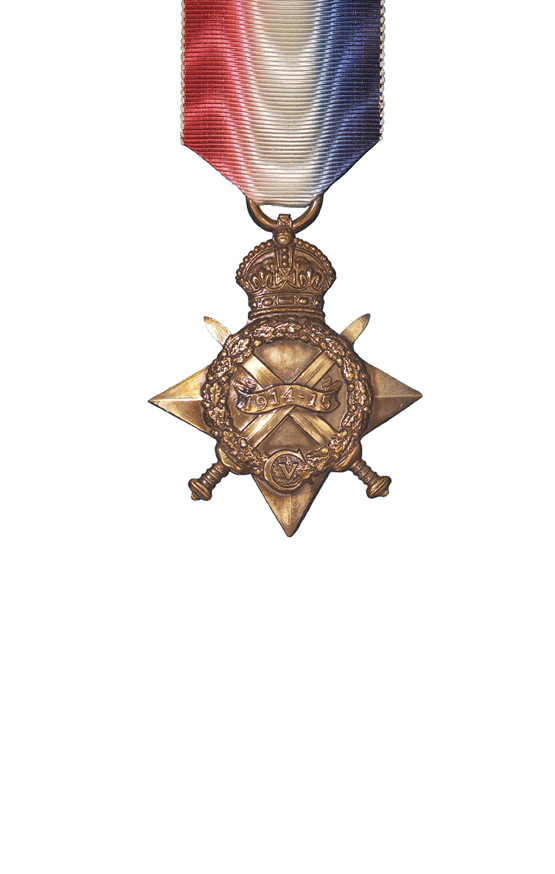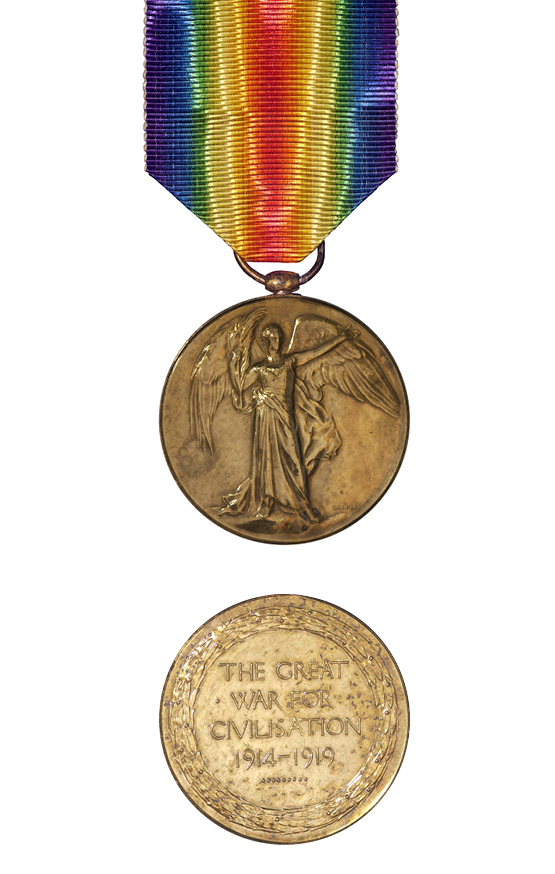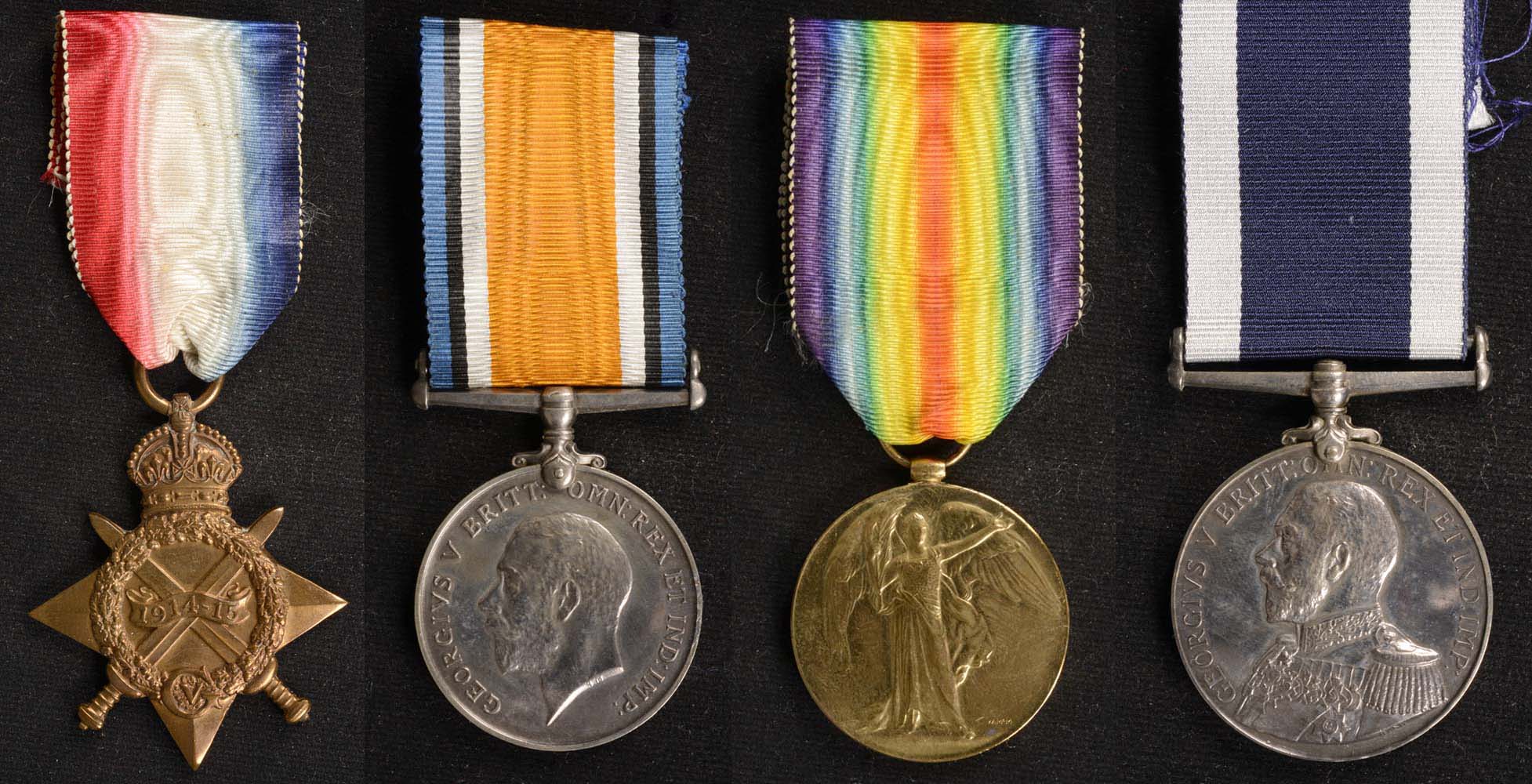

Display No. 2D
PEARCE, Charles
Charles Pearce joined the Royal Navy in 1896 as a Boy Seaman. He trained in HMS Impregnable, before being posted to HMS Arrogant as an Ordinary Seaman in 1898. In 1899 Pearce began further training in gunnery, torpedoes, and seamanship before being assigned to HMS Phoebe in early 1901, for the ship’s voyage to the Australian Station. Pearce was based on the Australian Station for three years before returning home in HMS Ringarooma.
After a period of further training, Pearce reached the rate of Petty Officer 1st Class in 1906. Pearce took a two year posting in the shore establishment HMS Boscawen. In 1909 he was posted to the armoured cruiser HMS Cornwall. Cornwall was posted to the North America and West Indies Station. In 1911 Pearce was part of the commissioning crew of HMS Indefatigable assigned to the 1st Battlecruiser Squadron. Pearce received his Long Service and Good Conduct Medal while on board. He remained with Indefatigable for two years.
At the outbreak of the First World War, Pearce was assigned to the battleship HMS Prince George which served in the Channel Fleet and later the Dardanelles. The ship was present at the Gallipoli landings. He then served at the torpedo and mining school ship HMS Defiance until the end of the war. He reached the rate of Gunner in 1917, and was discharged from the Royal Navy in late 1919. He then transferred to the Royal Australian Navy for a posting in HMAS Tasmania.
Awarded medal(s)
Medal Description [Left to Right]:
The 1914-1915 Star

The 1914-15 Star was awarded to servicemen and servicewomen who served in the First World War between 5 August 1914 and 31 December 1915 in any “theatre of war”, provided they had not qualified for the 1914 Star. This included service at Gallipoli between 25 April 1915 and 31 December 1915, service in Egypt between 5 November 1914 and 31 December 1915, and service during the capture of German Samoa on 29 August 1914. Those eligible for the medal must have “served on the establishment of a unit in a theatre of war” during the relevant dates of operations in that area. The ribbon’s red, white and blue shaded and watered bands represent the flag of the United Kingdom.
The British War Medal

The British War Medal was instituted in 1919 to recognise the successful conclusion of the First World War (1914-1918). Its coverage was later extended to recognise service until 1920, recognising mine clearing operations at sea, and participation in operations in North and South Russia, the eastern Baltic, Siberia, the Black Sea and the Caspian Sea.
The Victory Medal

The Victory Medal was awarded in the First World War to all those who had already qualified for the 1914 Star or the 1914-15 Star, and to most persons who had already qualified for the British War Medal. The Victory Medal was awarded to all New Zealand troops serving overseas, except for those who arrived in Samoa after 30 August 1914 and those serving in Great Britain only. It has a unique double rainbow ribbon.
A bronze spray of oak leaves on the medal ribbon denotes that the recipient was Mentioned in Despatches during the period that the medal recognises. To be Mentioned in Despatches a member of the armed forces has had their name mentioned in an official report, written by a superior officer, and sent to a higher command. The report would describe the individual’s gallant or meritorious action in the face of the enemy.
Royal Naval Long Service and Good Conduct Medal

Awarded to ratings who have served a minimum of 15 years in the Royal Navy (previously 21 or 10 years), the first version of this medal was instituted in 1831 and it is still issued to Royal Navy personnel today. It features the reigning monarch’s head on the obverse and HMS Victory on the reverse with the recipient’s details engraved or impressed on the edge of the medal. This medal was also issued to eligible personnel serving in the New Zealand Division of the Royal Navy from 1921-1941 and then to Royal New Zealand Navy personnel from 1941-1981. In 1985 a New Zealand Royal Navy Long Service and Good Conduct Medal was introduced bearing the exact same design.

